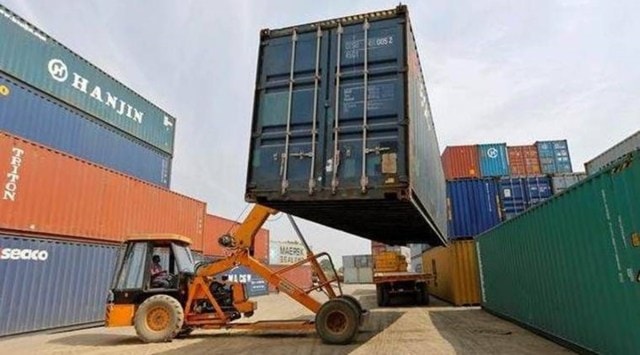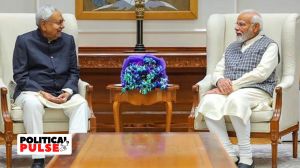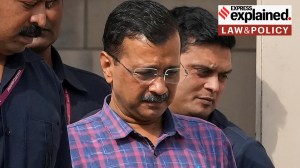- India
- International
Govt plans to raise duty on non-essential goods
In the current form, HSN codes are seen as subsuming a broad sweep of items, even at the six or eight-digit classification levels. For instance, there are different types of materials for bicycle hubs including steel, alloy, ceramics but all bicycle hubs come under the same HSN code.
 Import growth was weaker-than-expected at 5.4 per cent year-on-year in November as against revised 10 per cent in October. (Representational/File)
Import growth was weaker-than-expected at 5.4 per cent year-on-year in November as against revised 10 per cent in October. (Representational/File) WITH A SLOWDOWN in exports being seen as a cause of concern in the context of a widening trade deficit, the government is planning to regulate imports of “non-essential items” through hikes in import duties. The economic ministries in the Central government are in the process of carrying out an exercise to select a list of items on a granular basis to ensure that the proposed duty hikes are restricted to those items for which there is enough manufacturing capacity in the country, but not for other items in the categories that come under the same Harmonized System of Nomenclature (HSN) code.
“We are looking at non-essential imports for which there is enough manufacturing capacity. It is to identify non-essential items, where there is sufficient production capacity and allow for higher import substitution,” a senior government official told The Indian Express.
In the current form, HSN codes are seen as subsuming a broad sweep of items, even at the six or eight-digit classification levels. For instance, there are different types of materials for bicycle hubs including steel, alloy, ceramics but all bicycle hubs come under the same HSN code.
But with the government considering a higher import duty only for steel due to excess capacity domestically, it has to think of ways to separate other materials of bicycle hubs from the HSN category to ensure the higher import duty doesn’t affect them, the official explained.
Similarly, to regulate imports of LED lights, the government may consider levying higher duty only for the single-wire LED light but doesn’t intend to put a higher duty on LED bulbs. Hence, the government has to segregate the different types of LED lights to make sure it’s levied only on the types it wants to stop.

The trade challenge
TO REDUCE trade deficit, the government’s policy options are to push exports or disincentivise imports. But a poor outlook on global growth means India’s exports will suffer just like most other countries. The other way is to hike duties on imports, particularly those that are not critical and are produced in India. This will keep the deficit down.
The last set of duty hikes across a range of product categories happened in Budget 2022-23. Higher custom duties on items of daily use such as umbrellas, headphones, earphones, loudspeakers, smart meters, and imitation jewellery were introduced. Most of these products were being imported from China, either as complete units or as knocked down units to be assembled in factories in India.
Over the last five years, import duty hikes have been made on several occasions such as on almonds, apples, and others. Mobile phone parts and solar panels have seen the most regular hikes, in large part to protect and promote the domestic industry.
Prior to the large-scale hikes, India’s peak customs duty — the highest of the normal rates — on non-agriculture products had come down steeply from 150 per cent in 1991-92 to 40 per cent in 1997-98 and subsequently, to 20 per cent in 2004-05 and 10 per cent in 2007-08. Import tariffs have subsequently gone up sharply since 2017-18 and had hit 17.6 per cent by 2019-20 and has risen further since.
Higher imports are being seen as a worry for its impact on widening trade gap as exports remain weak amid a global slowdown in demand. Though merchandise exports reversed the negative trend by posting a marginal 0.6 per cent year-on-year growth in November after (-) 12 per cent in October, the trend remains weak. “On average, export growth fell -5.8% y-o-y in Oct-Nov, versus 8% in Q3, suggesting the underlying trend remains weak. Oil export growth fell to -1.7% y-o-y from 17.6% in October, reflecting lower global crude oil prices and the windfall taxes on petroleum products, while non-oil exports rose to a still-sluggish 0.8% y-o-y from -16.9% in October,” Nomura said in a note after the release of trade data Friday.
Import growth was weaker-than-expected at 5.4 per cent year-on-year in November as against revised 10 per cent in October (previous: 5.7 per cent). “Oil import growth eased to 10.5% y-o-y from 48% in October, while core import growth (non-oil, gold, gems & jewellery) picked up sequentially but remained sluggish at 6.6% y-o-y in November versus 4.6% in October — a sign of weakening domestic demand and lower demand for imported inputs,” it said.
Domestic demand is being seen to be met through higher imports as manufacturing output weakened, as seen in the latest factory output data for October and Gross Domestic Product (GDP) figures for the July-September quarter. Factory output slumped to a 26-month low of (-) 4 per cent in October, with manufacturing output, which accounts for 77.6 per cent of the weight in the IIP, contracting 5.6 per cent in October as against 3.3 per cent growth in the previous year.
A contraction was also recorded for capital goods output — a proxy for investment sentiment — indicating weak investment along with consumer durables and consumer non-durables output — an indicator of fast-moving consumer goods, reflecting weak consumption demand, especially in rural areas Experts said that with global slowdown and supply chains getting impacted in the aftermath of Russia-Ukraine war, most countries are likely to opt for higher trade barriers. “If I am going to get (-) 4 per cent in domestic manufacturing, then people who were importing raw materials and parts, they are importing less. The point is imports are not going down as fast as exports, so the current account deficit is increasing… domestic manufacturing is in deep trouble, that’s showing up in GDP figures and IIP figures and the base of demand for manufacturing is not doing anything. It’s the MSMEs in manufacturing which are worse off, they employ people who consume what they produce. We consume import intensive products. We are delivering services and consuming imports. The people who consume domestically produced goods, they don’t have income, they don’t have jobs and the job market continues to look bad with employment in agriculture higher than three years ago,” former Chief Statistician Pronab Sen said.
Buzzing Now
May 10: Latest News
- 01
- 02
- 03
- 04
- 05







































